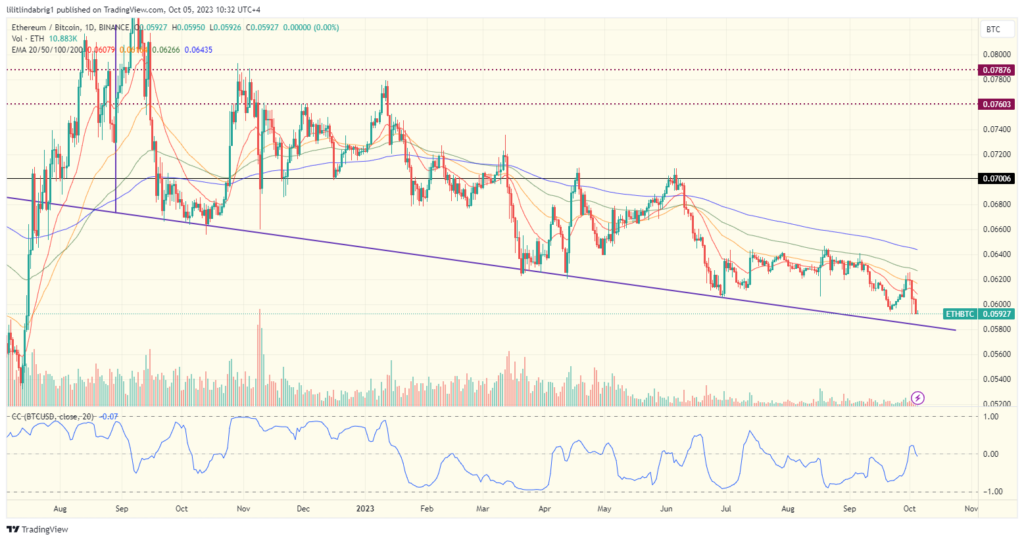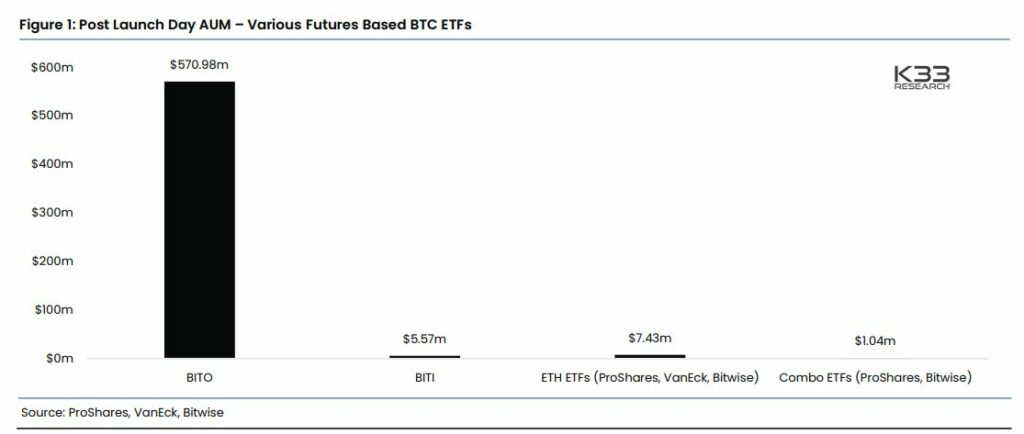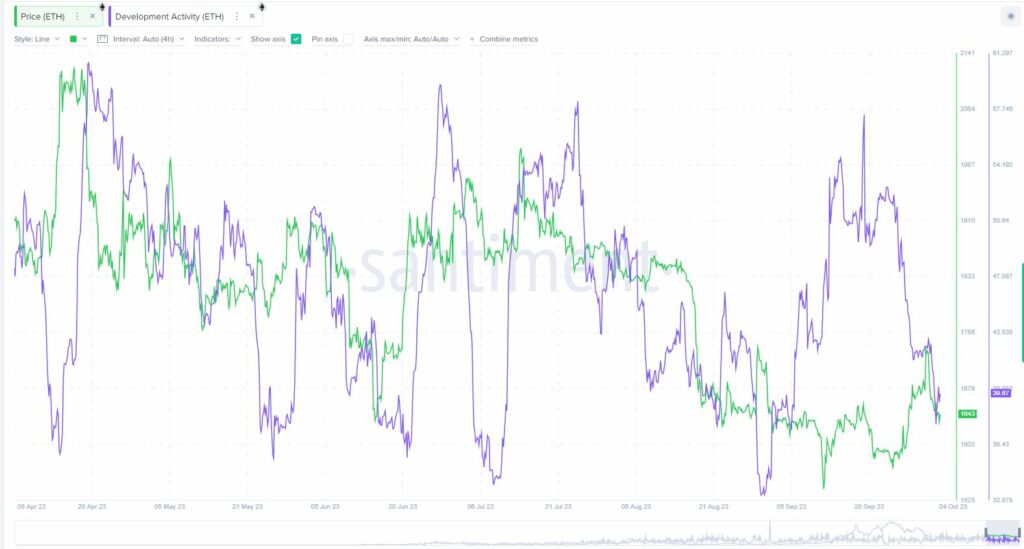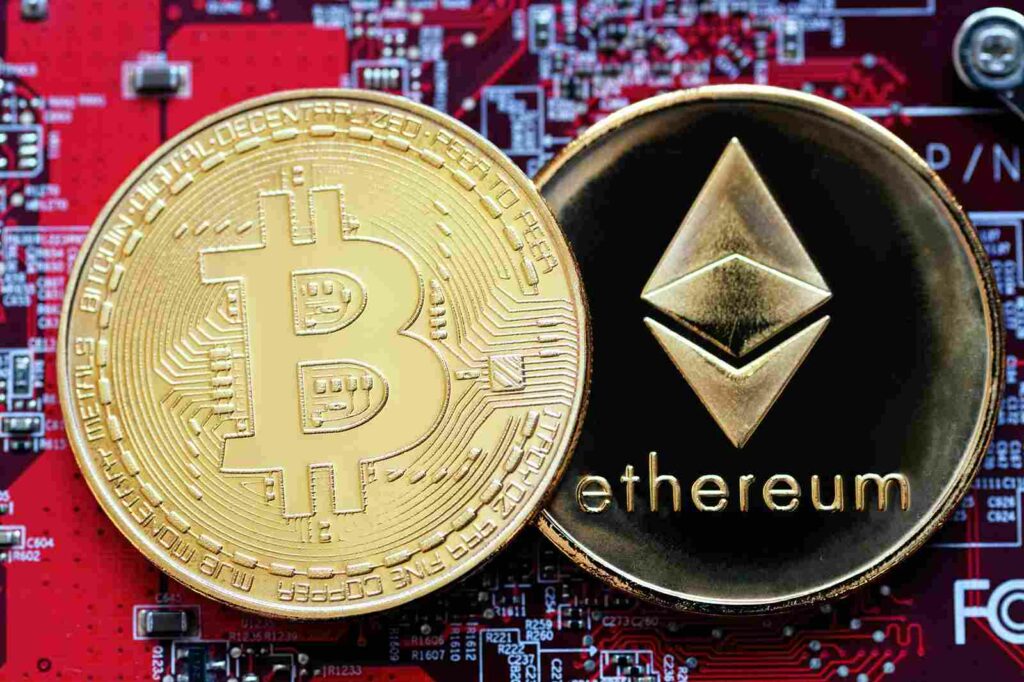Key Takeaways:
- Investors should consider parking their funds in Bitcoin rather than Ethereum in 2023.
- Institutions lack the incentive to dive into Ethereum, as evidenced by underperforming futures ETFs.
- Bitcoin halving presents a window for potential buyers, while the lowering development activity on Ethereum poses a concern.
YEREVAN (CoinChapter.com) — Bitcoin (BTC) rallied near 70% year-to-date and stood at $27,700 on Oct 5, after a month of sideways consolidation. Ethereum (ETH), on the other hand, rose 37% in the same period, generally adopting Bitcoin’s bias, and traded around $1,640 on Oct. 5.
So, why should the traders bet on BTC in Q4 instead of ETH? Let’s dive in.
#1 A Dwindling ETH/BTC Exchange Rate
The ETH/BTC exchange rate has dropped nearly 20% year-to-date.

Declining NFT on-chain activity and increasing L2 usage, which reduces gas consumption and, in turn, organic demand for ETH, has dwindled in 2023. In addition, the DeFi sector activity has been low.
On the other hand, Bitcoin was considered a safe haven during the banking crisis earlier in 2023. In addition, growing hopes around a potential Bitcoin exchange-traded fund (ETF) approval by the US authorities have also boosted investors’ appetite for the coin.
As a result, ETH/BTC could decline further in the coming months.
#2 No Institutional Appetite for ETH
Institutions are key in determining market bias because of their higher capital exposure. Therefore, analysts typically track institutional sentiment to gauge whether an asset will grow or decline in value.
According to data from CoinShares, while investors parked $168 million in Bitcoin year-to-date, Ethereum saw $114 million worth of outflow.
The weekly flows at the end of September paint a similar picture, with over $20 million going into Bitcoin and $1.5 million flowing out of Ethereum, the seventh consecutive week of outflows for the leading altcoin.

Moreover, the disappointing launch of Ethereum futures ETFs influenced the markets. Read more below.
#3 Underperformance of ETH-based ETFs
Investment firms ProShares, Valkyrie, Bitwise, VanEck, Kelly, and Volshares launched nine ETFs on the Chicago Board Options Exchange (CBOE) on Oct. 2. However, the launches did not draw the expected investor attention.
As a result, past BTC-related futures ETF launches completely dwarfed Ethereum ETF launch volumes, confirming the lack of demand for ETH exposure.
For example, ProShares Bitcoin Strategy ETF (BITO), the first BTC-based ETF in the US, had just under $571 million in assets under management (AUM) on the first day after launch. At the same time, inflow in ETH-based ProShares, Vaneck, and Bitwise ETH ETFs stood at merely 7.4 million.

Arguably, Ethereum ETFs slumped partially due to weak timing and not structural deficiencies. While the mentioned Bitcoin futures ETFs kicked off in a bull market, Ethereum ETFs faced many macroeconomic headwinds.
Moreover, crypto exchange-traded products (ETPs) have experienced a lengthy drought in activity. Even BITO has faced consistent outflows since mid-July and saw its third-lowest average daily volume (ADV) in September 2023. However, despite the ubiquity of the downturn, Bitcoin, unlike Ethereum, has another ace up its sleeve – the upcoming halving.
#4 Bitcoin accumulation window pre-halving.
While consolidating markets remains a key theme for Q4 2023, experts anticipate a bullish Bitcoin move by the end of 2024 due to the approaching halving event.
In detail, a Bitcoin halving is when the payout for mining a new block is halved, which happens after every 210,000 blocks (approximately four years).
The first halving occurred in March 2012, July 2016, and May 2020. Based on current estimates, the next Bitcoin halving will occur on April 26, 2024, at 18:30 UTC on block 840,000. It will reduce the block reward to 3.125 BTC.

Notably, each of the three previous halvings brought on a bullish wave, albeit not immediately, taking up to 33 months. Thus, the now–flat markets could present an accumulation window for long-term Bitcoin investors.
#5 Low development activity on Ethereum + growing centralization
According to on-chain data provider Santiment, development activity on Ethereum has declined by over 30% since Sep 20, which is a bearish sign for a DeFi platform.

Moreover, the percentage of ETH held by the top 10 addresses has risen from 26% in early April to 34% on Oct 5, while the top 100 holders possess nearly half of all ETH supply at 47%. The growth of centralization leaves retail investors more dependent on large market players.

The post Buy Bitcoin, Sell Ethereum — 5 Reasons Why appeared first on CoinChapter.







